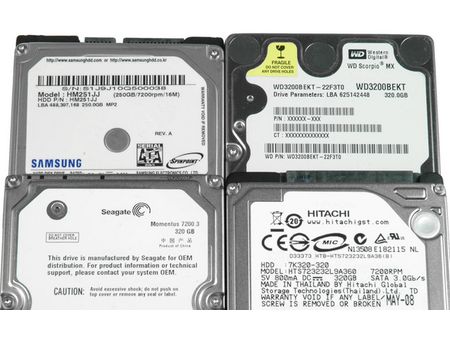Next-Gen 7,200 RPM Notebook Hard Drives
Notebook Hard Drives Reach 90 MB/s
160 GB, 200 GB, 250 GB, 320 GB: It’s amazing to follow the fast pace of progress in the notebook hard drive sector. Only six months ago, we looked at high-performance notebook hard drives, which had reached 200 GB capacities at that time. The latest high-performance product generation has not only increased the maximum capacity to a comfortable 320 gigabytes, but performance has also increased along the way.
High-Performance or Mainstream
When we refer to high-performance notebook drives, we’re talking about 7,200 RPM spindle speed units in the 2.5” form factor with a 9.5 mm height. Most 2.5” hard drives have this height of 9.5 mm, which allows them to be installed into all notebook computers designed for this industry standard. Some ultra-portable notebooks require 1.8” disk drives, though, while others offer additional space for 12.5 mm 2.5” drives (Hitachi’s 500-GB Travelstar 5K500 is a 12.5 mm drive).
Drive Features
High-performance drives running at 7,200 RPM typically get warmer, produce more noise and do not offer the same high capacities as mainstream drives that spin at a more conservative 5,400 RPM. Cache capacities vary between 8 MB and 16 MB, although the difference isn’t noticeable in typical use scenarios. All 2.5” high-end hard drives come with Serial ATA interfaces and support native command queuing (NCQ), which allows drives to reorder incoming commands for more efficient execution. All of this also applies to most of the mainstream drives. Whether SATA/150 or SATA/300 interface speeds are used does not matter in everyday life, as 2.5” drives cannot even come close to the 150 MB/s bandwidth of first-generation Serial ATA.
Some drives come with built-in encryption, while others feature a free-fall sensor, which is capable of parking the heads if increased acceleration is detected. This helps to avoid physical damage, if, for example, you drop your notebook by accident. Power management is another feature to which we dedicate additional testing in this article, as some drives offer more sophisticated power management than others.
Performance Counts
Get Tom's Hardware's best news and in-depth reviews, straight to your inbox.
2.5” drives running at 4,200 RPM will die out by the end of the year, as the difference in cost, noise, heat and power consumption between 4,200 and 5,400 RPM is little, while performance is noticeably better at 5,400 RPM. The next step to 7,200 RPM further shortens access time and provides improved transfer rates at the expense of capacity. Since hard drives have always been the slowest core system component, this is usually a worthwhile trade off.
Current page: Notebook Hard Drives Reach 90 MB/s
Next Page Options: Encryption, Free Fall Sensors